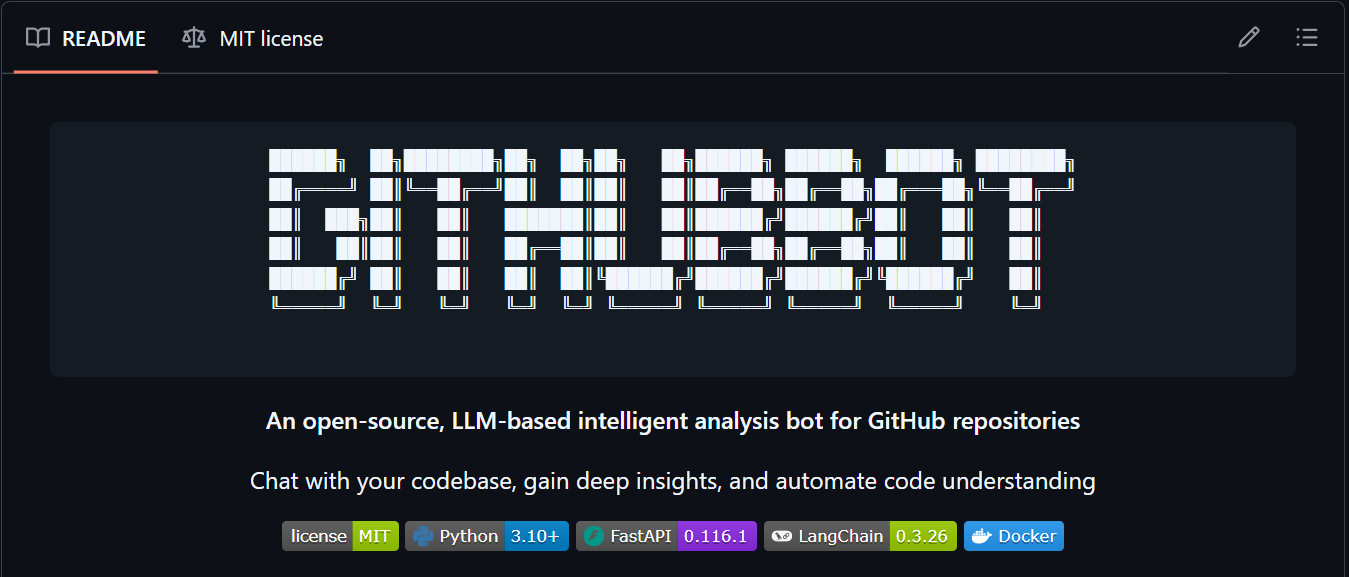GithubBot

GithubBot is a powerful AI framework designed to revolutionize how developers interact with codebases. It automatically “learns” an entire GitHub repository—including all its code and documentation—and answers any questions about it in natural language through an intelligent chatbot, from “What does this function do?” to “How do I implement a new feature?”.
🚀 Core Features
- 🤖 Intelligent Code Q&A: Provides precise, context-aware code explanations and suggestions based on Retrieval-Augmented Generation (RAG).
- ⚡️ Fully Automated Processing: Simply provide a GitHub repository URL to automatically clone, parse, chunk, vectorize, and index the code.
- 🔌 Highly Extensible: Easily swap or extend LLMs, embedding models, and vector databases. Supports various models like OpenAI, Azure, Cohere, and HuggingFace.
- 🔍 Hybrid Search: Combines vector search with BM25 keyword search to ensure optimal context retrieval for various types of queries.
- ⚙️ Asynchronous Task Handling: Uses Celery and Redis to manage time-consuming repository indexing tasks, ensuring API responsiveness and stability.
- 🐳 One-Click Deployment: Comes with a complete Docker Compose setup, allowing you to launch all services (API, Worker, databases, etc.) with a single command.
🛠️ Tech Stack
- Backend: FastAPI, Python 3.10+
- AI / RAG: LangChain, OpenAI, Cohere, HuggingFace (extendable)
- Database: PostgreSQL (metadata), ChromaDB (vector storage)
- Task Queue: Celery, Redis
- Containerization: Docker, Docker Compose
- Data Validation: Pydantic
🚀 Quick Start
You can get GithubBot up and running in minutes with Docker.
1. Prerequisites
- Docker: Install Docker
- Docker Compose: Usually included with Docker Desktop.
- Git: To clone this project.
2. Clone the Project
git clone https://github.com/oGYCo/GithubBot.git
cd GithubBot3. Configure Environment
The project uses a .env file to manage sensitive information and configurations. Please note: The project includes a .env.example file. You need to create your own .env file from it.
cp .env.example .envThen, edit the .env file and add at least your OpenAI API key:
# .env
# --- LLM and Embedding Model API Keys ---
# At least one model key is required
OPENAI_API_KEY="sk-..."
# AZURE_OPENAI_API_KEY=
# ANTHROPIC_API_KEY=
# ... other API keys4. Launch Services
Build and start all services with a single command using Docker Compose:
docker-compose up --build -dThis command will start the API service, Celery worker, PostgreSQL, Redis, and ChromaDB.
5. Check Status
Wait a moment for the services to initialize, then check if all containers are running correctly:
docker-compose psYou should see the status of all services as running or healthy.
📖 API Usage Example
Once the services are running, the API will be available at http://localhost:8000. You can access the interactive API documentation (Swagger UI) at http://localhost:8000/docs.
1. Index a New Repository
Send a POST request to the following endpoint to start analyzing a repository. This is an asynchronous operation, and the API will immediately return a task ID.
- URL:
/api/v1/repositories/ - Method:
POST - Body:
{
"repo_url": "https://github.com/tiangolo/fastapi"
}Example (using cURL):
curl -X 'POST' \
'http://localhost:8000/api/v1/repositories/' \
-H 'accept: application/json' \
-H 'Content-Type: application/json' \
-d '{
"repo_url": "https://github.com/tiangolo/fastapi"
}'2. Check Analysis Status
Use the session_id returned from the previous step to check the analysis progress.
- URL:
/api/v1/repositories/{session_id}/status - Method:
GET
3. Chat with the Repository
Once the repository status changes to COMPLETED, you can start asking questions.
- URL:
/api/v1/repositories/{session_id}/query - Method:
POST - Body:
{
"query": "How to handle CORS in FastAPI?"
}Example (using cURL):
curl -X 'POST' \
'http://localhost:8000/api/v1/repositories/{your_session_id}/query' \
-H 'accept: application/json' \
-H 'Content-Type: application/json' \
-d '{
"query": "How to handle CORS in FastAPI?"
}'⚙️ Environment Configuration Details
You can customize almost every aspect of the application in the .env file.
| Variable Name | Description | Default Value |
|---|---|---|
API_PORT | Port for the API service to listen on | 8000 |
POSTGRES_USER | PostgreSQL username | user |
POSTGRES_PASSWORD | PostgreSQL password | password |
REDIS_HOST | Redis service address | redis |
OPENAI_API_KEY | OpenAI API key | "" |
CHUNK_SIZE | Maximum size of text chunks | 1000 |
CHUNK_OVERLAP | Overlap size between text chunks | 200 |
VECTOR_SEARCH_TOP_K | Number of documents from vector search | 10 |
BM25_SEARCH_TOP_K | Number of documents from BM25 search | 10 |
ALLOWED_FILE_EXTENSIONS | List of allowed file extensions | (see config.py) |
EXCLUDED_DIRECTORIES | List of directories to ignore | .git,node_modules,... |
📄 License
This project is licensed under the MIT License. See the LICENSE file for details.
🚀 Developed by oGYCo.